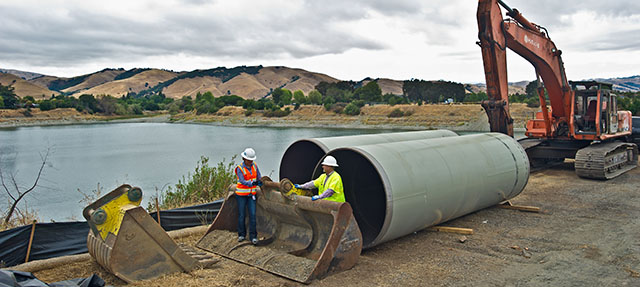This commentary was published in CalMatters on September 21, 2020
California’s water managers have had their hands full keeping our water systems safe and operational during the COVID-19 pandemic. But their work on addressing the fiscal consequences of the deep economic recession is just beginning. Three lessons from the Great Recession of the late 2000s could guide more effective policy responses today.
First, a bit of budgeting context: California’s water sector is large, with annual spending of about $35 billion (Figure 1). Most is for the core functions of water supply and pollution prevention, with smaller amounts for managing floods and ecosystems and retiring debt from past water bonds. Local agencies fund the lion’s share (85%)—principally from water and wastewater bills. But state and federal tax dollars help fill gaps—especially for “fiscal orphans” like safe drinking water in poor communities, ecosystem and watershed restoration, and flood protection, which lack reliable local sources of funding.
These lessons from the Great Recession offer perspective for taming this downturn’s impact on water management:
- Water and wastewater revenues are vulnerable in recessions. In tough economic times, even relatively reliable funding like water and wastewater bills can decline, as affected residents and businesses are unable to pay. Initially, many utilities can draw on reserves, but ultimately the declines cut into capital budgets for aging infrastructure. Water and wastewater revenues fell by 6% during the Great Recession, and did not start rebounding until 2011 (Figure 2). Declines could be both deeper and longer-lasting this time, given the greater severity of this recession and the new state policy that protects water customers from shut-offs for nonpayment. Solutions must simultaneously address the public health need of water for all, while protecting utilities’ ability to keep their systems safe. Expanding lifeline programs that make water more affordable for low-income residents is one option. Providing minimal service to those who don’t pay their bills, rather than shutting off the taps, may also be a promising approach.
- Ecosystem spending is vulnerable to swings in state bond funding. Programs to restore California’s threatened freshwater ecosystems rely heavily on voter-approved state bonds. But bonds are not recession-proof. During the Great Recession, the state paused the distribution of bond funds—putting many ecosystem efforts on hold. The slow recovery also delayed placement of a new bond on the ballot, causing another spending drop until new funds became available in 2015 (Figure 3). This year, the state has not cut bond spending, but the proposed Climate Resilience Bond is on hold. Diversifying the funding portfolio is key to more robust ecosystem programs. Land assessments—such as the Bay Area’s program to protect, restore, and enhance San Francisco Bay—and surcharges on water use—such as the Central Valley Project’s restoration fund—have been effective alternatives in some watersheds.
- Federal stimulus spending can help fill gaps. The federal government has the capacity to spend money during a recession in ways that state and local governments can’t. The 2009 American Recovery and Reinvestment Act (ARRA) made $13.5 billion available for “shovel-ready” water infrastructure projects to support economic recovery. Although California saw little net benefit in some ARRA-funded areas, like flood management, the state’s water supply and wastewater utilities received a major boost (Figure 4). To date, there have been discussions—but no agreements—about federal stimulus spending for water. California would be well-served by federal funding that fills pre-existing gaps for water’s fiscal orphans. This includes providing access to safe and clean water in poor communities whose water systems were underperforming even before the current crisis, and boosting the water system’s resilience to the changing climate.
COVID-19 and growing climate extremes brought major challenges to water managers across California this year. Nimble fiscal solutions—making the most of local, state, and federal water dollars—are now needed to avoid lasting social, economic, and environmental consequences of the recession.




